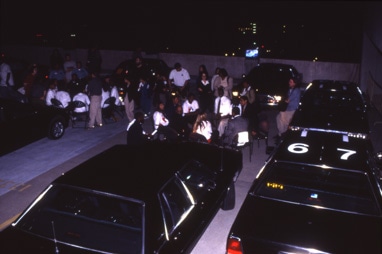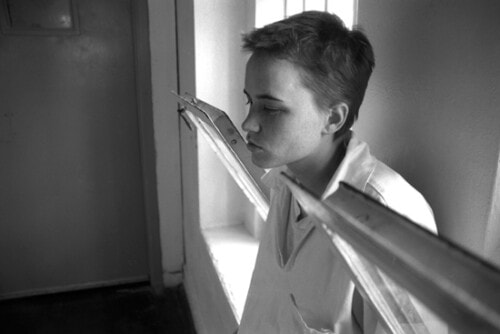This is a brief reflection on the pedagogical offerings in Dána-Ain Davis’s most recent book Reproductive Injustice (NYU Press, 2019) for those of us who teach about reproduction with a focus on Black reproduction specifically. While there now exists a plethora of quality texts to engage students in deep critical thinking on the complex politics governing what, how, where, when, why, and with whom we reproduce, it can be a challenge to organize these texts into a course that encourages students to wrestle with the serious issues at hand and retain their resolve to resist, organize, and create anew. As a junior faculty member, I teach an upper division undergraduate course called “Reproducing While Black” where we explore the stakes of Black reproduction globally. I have been teaching this class for four years. In this essay, I reflect on what Davis’s book offered to my course design and how it changed my ability to teach difficult material. The story of this course, like the stories in Davis’s book, illuminates some of the challenges to understanding the complexities of reproducing while Black and offers modes of resistance.
I teach “Reproducing While Black” through the Department of African American Studies. The course is not cross listed, nor does it fulfill a general education requirement. This is intentional. Because you must find the course in my department’s offerings, it draws a self-selecting group of students. Over the years, students have asked me not to change this dynamic by listing it more publicly or opening it up to more students. The class is usually capped at twenty-five, but I always end up letting in anywhere from five to ten more. The overwhelming majority of students are Black or Latinx and identify as women. They come from diverse majors like Biology, English, African American Studies, Psychology, Anthropology, and Political Science. Many students don’t know what to expect from the class but come based on recommendations from friends and their own interest in reproduction.
Earlier iterations of this class dealt more generally with questions of gender, race, and reproduction, but after a few years I focused the course specifically on Blackness and Black reproduction with materials addressing the discourse and practices surrounding what was and continues to be dubbed a crisis of maternal mortality for Black women. In mainstream media and in academic studies, I was bombarded by a narrative of Black women and infants dying at higher rates than their white counterparts as though this was a new phenomenon. There was nothing new about it, not in the US or abroad. By shifting the focus, I hoped students would grasp that point, among other important points about the intersections of race, gender, class, sexuality, and the legacies of colonialism and slavery on current conditions for reproduction.
As one can imagine, this is a hard class to teach. Students often felt increasingly troubled as we moved through the ten weeks of the quarter. They looked for ways to end the class on a more positive note, or at least to find some glimmer of hope in examples of resistance against what had and continued to constrain the reproductive experiences of Black people.
Dr. Davis’s work, particularly “Chapter 6: Radical Black Birth Workers” and “Conclusion,” provided some such hope. Students learned about contemporary Black birth workers, the legacy of Black midwives in the South, and strategies for improving birthing experiences for Black people. Students were reminded that Black folks have always fought back and found ways to address the racism, neglect, mistreatment, exposure, injury, and death forced upon us by medical and health systems and practices, particularly in obstetric care. Several students expressed interest in becoming midwives, doulas, or birth workers. Besides inspiring hope in the students, Davis provided a more gracious articulation of the ways that the concept of obstetric violence failed to be sufficient in characterizing and analyzing the nuances and specificity of Black birthing people’s experiences in pregnancy, labor and childbirth, and postpartum, and the role that racism played.
Before I taught this book, I had been so focused on making sure that I imparted an understanding of the long history of what was being characterized as recent that I got stuck in the specificity. I lost sight of our purpose. Although I wanted students to understand that Black thinkers, Black women, and Black activists had been speaking and writing against medical racism and its many iterations for generations, I failed to think more critically about what it might do to my Black students in particular to be inundated with this racist violence. In what state would I leave their physical, emotional, and mental health after discussions about Black women and our children’s vulnerability to death in Western medicine’s hands? The solution seems so glaringly obvious now, but at the time I considered not teaching the course at all. How else could I avoid leaving students broken, scared, hopeless, forbidding reproduction, or in a hurry to have children to improve their chances for life? I was open about this dilemma with my students. They, in turn, discouraged me from giving up, pointing out that it was better for them to have this space to learn and equip themselves to strategize towards better outcomes.
But before making the critical decision to continue, I had the opportunity to attend a panel discussion on Davis’s book. After listening to beautiful, engaged commentary from the panelists and Davis’s insightful responses, I went up to Davis to see if I could ask her about the issue I was having with my class. The advice she gave has helped me approach my teaching differently to the benefit of my students and myself. She told me to add examples of good reproduction and, as she did in the book, talk about our responses to racism and excessive exposure to death. A simple enough task but one that could radically change how Black students and other students of color engage with learning about our hard histories. I think often about the callous ways that Black children are taught about slavery devoid of resistance outside narrow discussions of Harriet Tubman, Frederick Douglass, and the movie Roots. Of course, the degree to which this is true varies and depends on the school, but this was definitely how it was taught to me from elementary through high school. I had fallen into a pedagogical problem I knew and hated so deeply, and yet the solution emerged after enlisting my broader intellectual community: a senior colleague and my students.
I offer this story because it was an eye-opening experience for me. At some point much earlier in my life, I began to despise happy endings. I felt they were an imposition and I resisted them, and this translated into how I was teaching. I did not want to naively characterize acts as resistance when they may not have been, or when such a characterization masked brutal realities. I also did not want to paint a more rose-colored picture than my students could realistically expect. And somehow, although I had intended otherwise, I landed in a space that was not comfortable for me or my students. My students recognized that balance was needed to hold both history and the present reality and it came through most clearly in Davis’s work.
There is much more that Davis’s book offers to anyone interested in using it as material or as a model for teaching. But Davis’s work isn’t just the theoretical or intellectual work on the page; sometimes you meet a scholar and realize that is the case. Even in our brief conversation, Davis demonstrated that her work was not work for the sake of it but for the sake of our pedagogy, our activism, and our everyday. Deep gratitude and admiration fail to capture how I feel about Dr. Davis and how she shows up in the world as scholar and human being. Her integrated approach inspires me to do the same. She reminds me of all we can do in our writing, our approach to scholarship, our teaching, our mentorship, even our chats in the hallway.
WORKS CITED
Davis, Dána-Ain. Reproductive Injustice: Racism, Pregnancy, and Premature Birth. New York: NYU Press, 2019.




